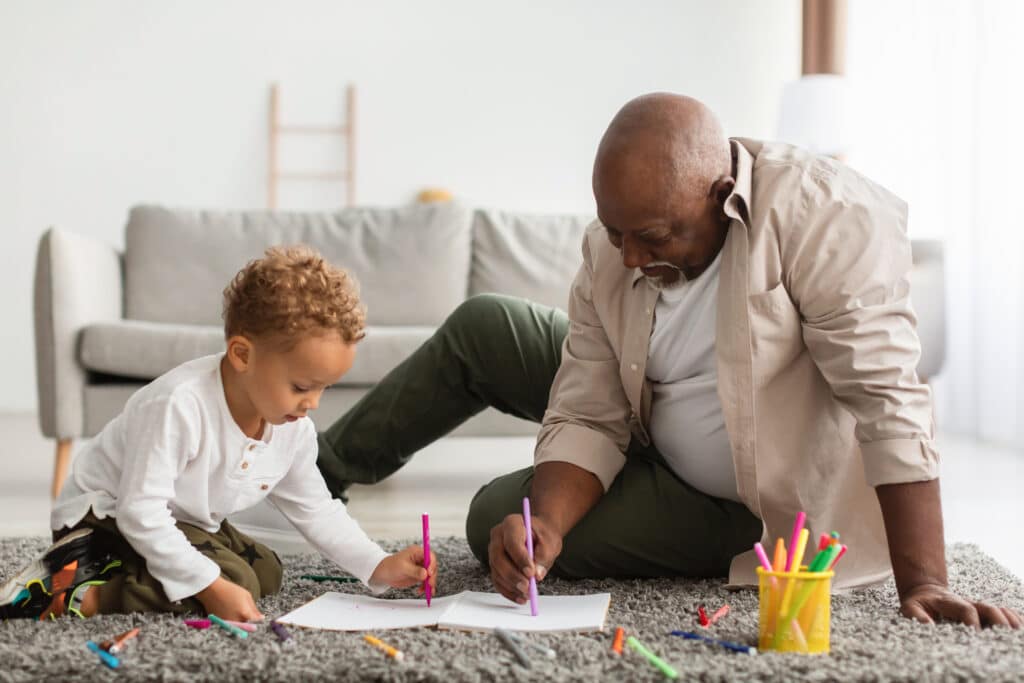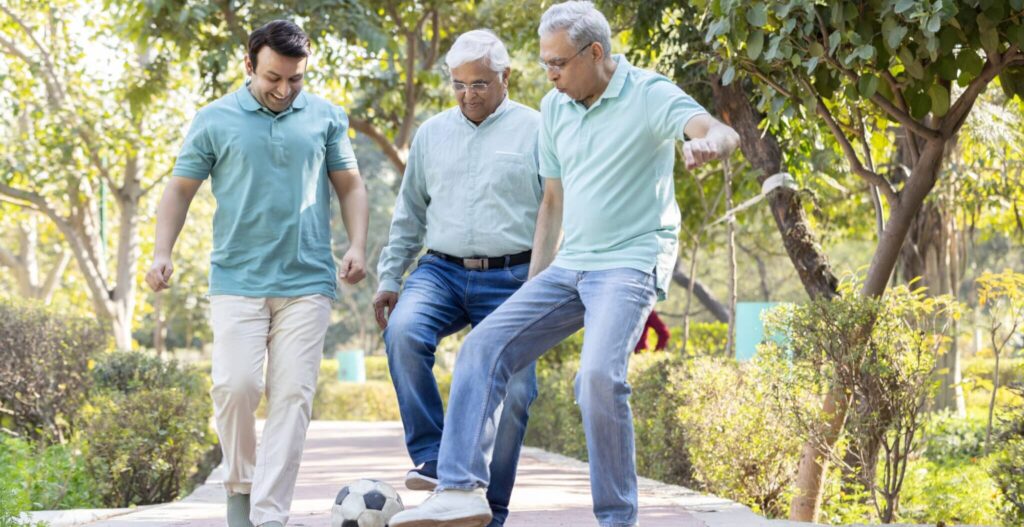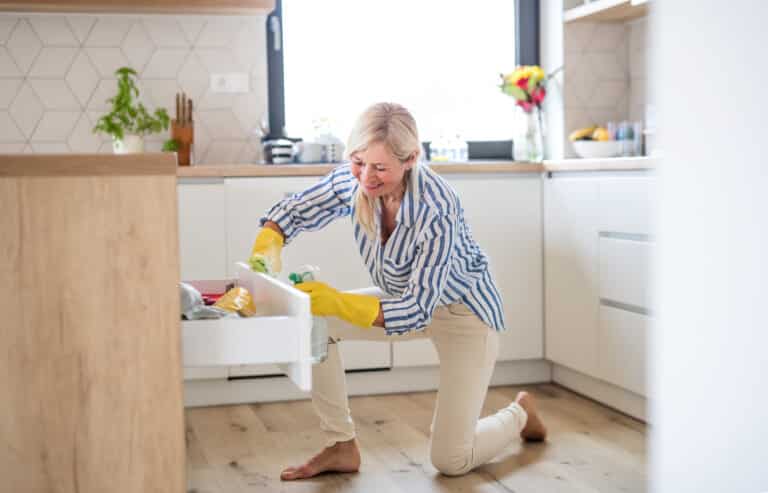As we age, balance issues and injuries can seem to occur out of the blue, even while doing familiar or seemingly simple tasks. Fortunately, these sorts of injuries are often preventable with a little extra attention to how we move.
Body mechanics can play a major role in helping reduce pain, improving your balance, and reducing the risk of falling or injury for many seniors.
We’re all different, and body mechanics vary from person to person based on prior injuries, pain, or range of motion restrictions. For example, falls commonly happen with simple daily life activities, such as walking, stepping over an object, or bending down to pick something up.
But like many popular exercise terms, body mechanics can be difficult to understand, especially if you’re beginning your fall prevention journey.
In this article, we will examine body mechanics, how they can be affected by posture, and tips and tricks for several scenarios where good body mechanics might prevent all-too-common injuries for older adults.
Let’s get started.
What Are Body Mechanics?
To start, ‘body mechanics’ refers to how your skeletal system, joints, and the muscles that move them function together to keep your body moving safely throughout your life. This is often referred to as functional movement or movements that we need to refine to utilize in our daily lives.
Just like mechanics that you might find in a car or some other machine, if parts come out of alignment, there are likely to be problems that result in wear and tear or breakdown. This article aims to help you better understand functional movement so you can feel and move better without pain.
Using good body mechanics means you have a better chance of avoiding these common injuries through good movement.
The Role of Proper Posture

Proper body mechanics are strongly related to what most people call good posture. When you maintain good posture, your joints are stacked to minimize abnormal stresses that might otherwise lead to tight muscles, muscle fatigue, and injury.
For example, to move correctly and safely, especially when doing a “mechanical lift”—like lifting a heavy object onto a high shelf—it’s essential to utilize your leg muscles rather than relying on the strength of your arms and back.
Poor body mechanics can cause movements like these to put extra strain on sensitive spinal structures and other joints and tissues that are often injured due to poor posture.
Your posture alone can significantly impact your balance, and correct posture should be practiced even while moving when possible.
For example, a forward flexed spine—a hunched position known as kyphosis—is a common cause of injury and may be due to poor habits, muscle weakness, or pain.
With a hunched position, your center of mass is shifted forward (more on your toes than the center of your foot), making you less stable and more likely to fall forward.
In short, proper posture results from good body mechanics, and vice versa. Next, we’ll look at some everyday household situations where good body mechanics can help you move better to prevent injuries before they occur.
Common Body Mechanics Challenges & How to Address Them

Feeling Unsteady on Your Feet: Posture and Walking
Ideally, your body should be aligned so that if someone looks at you from the side, your ears, shoulders, hips, knees, and ankles are in one vertical line. Your knees should have a soft bend in them to protect the joints.
Generally, you should stand with your feet flat, about hip-width apart, with your weight centered over the center of your feet. Some might call this a normal position for good movement and stability.
If you struggle with balance, widening your stance will help. Standing with your feet a little wider allows for a larger support base, making it more difficult to knock you off balance.
In my practice, I commonly see balance-challenged patients unknowingly shortening their step length due to fear of falling, which results in a shuffle rather than a normal walking gait. Short steps reduce your base of support, making it more challenging to maintain balance, and may even lead to falls.
For reference, a typical step length is around two-and-a-half to three feet per step, although this can vary based on factors like height and age. If you take shorter than average steps, it’s worth consulting with a physical therapist to evaluate your walking patterns.
Walking with a Cane
It may seem counterintuitive if you require an assistive device like a cane for walking, but hold the cane in the opposite hand of your weaker leg. For instance, if you have left knee pain, hold the cane in your right hand.
Progress the cane forward with each step of your weaker leg. This technique promotes regular trunk rotation and ensures your weight stays centered over your support base, improving your balance.
Stepping Over Obstacles
It’s often safest to look ahead when walking rather than staring down at your feet. Looking down causes your posture to bend forward, shifting your weight ahead of your feet instead of keeping it centered. Looking ahead allows you to anticipate and prepare for upcoming obstacles you need to navigate around or over.
When you know an object is in your path, it’s best to slow down or stop if necessary before stepping over it. Shift your weight slowly onto your most stable leg and step over with the weaker leg. If someone is with you, holding onto their shoulder can provide additional stability as you step over the obstacle.
Functional Movement Strategies for Daily Tasks
Although you may not have noticed before encountering balance issues, strength and balance in functional movement are deeply intertwined with many of your day-to-day activities.
Here are some everyday activities and how you may anticipate and prepare for unexpected balance challenges.
Lifting a Heavy Box or Laundry Basket

When it comes to lifting objects, particularly heavier ones like a laundry basket, a suitcase, or a bag of potting soil, it’s essential to prioritize the strength of your leg muscles rather than relying solely on your back.
Follow these steps for proper lifting technique:
Start with your feet slightly wider than hip-width apart to establish a stable base.
Engage your core muscles to provide support for your lower back.
Bend at your hips and knees, maintaining proper spine alignment as you drop your hips and lift your chest.
Shift your weight towards the middle or back part of your foot instead of leaning forward onto your toes.
The bending required at each joint can vary depending on your specific needs. If you experience knee pain, focus on bending at the hip joint while moving your hips backward. This movement can create a gentle stretch in your hamstrings. If your knees are more flexible, you can adopt a squatting position like sitting in a chair.
Aim to keep your back relatively straight throughout the lifting process to minimize strain. As you lift the object, keep it close to your body. This reduces the strain on your joints and enhances overall stability.
Remember to breathe naturally, inhaling before you lift and exhaling during the lifting motion. Following these guidelines can protect your body and promote safe lifting practices.
Reaching High or Low While Cleaning or Putting Away Dishes

When it comes to tasks like unloading a dishwasher or putting away groceries, which involve repetitive bending and reaching, it’s essential to take precautions to minimize pain and dizziness. Follow these steps for a safer and more comfortable experience:
Perform the movements slowly to reduce strain. Take short breaks between each bending motion, standing upright for a few seconds before repeating.
Maintain a hip-width stance when reaching into cabinets. This wider stance provides better stability and balance.
If the dish you’re handling is not too heavy or oversized, consider using one hand to hold the dish and the other to hold onto the countertop. This additional support can improve your stability during the reaching motion.
Engage your core muscles as you raise your arm(s) overhead. Be mindful of avoiding any excessive arching of your back during this movement.
Shift your weight forward into your toes while reaching for the appropriate shelf. If necessary, lift your heels slightly to help you reach comfortably.
These steps will help minimize the risk of discomfort or dizziness while putting dishes away, making the task more manageable.
Tips for Getting Up From a Comfy Chair
Getting up from a lower, softer chair can be challenging, especially if you experience pain or weakness in your legs and core. While using your arms to assist you can be helpful, here are some additional tips to make the process easier:
Prioritize using the strength of your legs to improve balance. Position your feet close to the chair, with your knees bent at approximately 90 degrees or more. This close proximity is important for a smoother transition to standing.
Shift your weight forward, allowing the movement to flow from your hips to your feet. It’s okay to use a gentle rocking motion to shift your weight into your feet, which can provide some momentum. Once your weight is evenly distributed in your feet, begin standing up by simultaneously straightening your hips and knees.
If you require assistance from your hands, place them on your knees or the chair’s armrests—avoid placing them behind you. Placing your hands behind you shifts your weight backward, making standing more challenging and less safe. As you initiate the standing motion, release your grip on the armrest and maintain an upright spine to keep your weight centered over your feet.
Avoid relying on a walker to pull yourself up from a seated position or to stabilize yourself while sitting. Walkers may not provide enough stability for this type of force and could tip over, increasing the risk of falls. Instead, keep the walker in front of you and use the chair’s armrests to push off. Once you are standing, you can transition your hands to the walker for additional support.
Playing on the floor

Engaging in activities like playing with grandkids or pets or practicing floor-based exercises such as yoga is essential to feel confident about getting back up from the floor. Here’s a step-by-step guide to help you navigate this process successfully:
Before getting on the floor, position yourself next to a sturdy piece of furniture, like a chair, that can provide stability and support when ready to stand up again.
When you’re on the ground, starting from a seated position, bend your knees and roll onto one side. Prop up your torso with your arm, ensuring your elbow is straight. Continue rolling forward until you’re on both hands and knees, ready to crawl.
From the hands and knees position, begin rising at your chest while keeping one hand in contact with the ground. Simultaneously, bring your opposite leg forward so your foot is flat on the floor. It’s generally recommended to bring your stronger leg forward in this movement. This position is known as “half-kneeling.”
From the half-kneeling position, place both hands on the knee that is up or onto the nearby furniture for added support. Curl the toes of your back foot under. Utilize the strength of both your legs and arms to push through and gradually come to a standing position.
Getting up and down from the ground is an invaluable and often overlooked skill for many older people. These essential practices will help you navigate getting on and off the floor more confidently, allowing you to enjoy activities and exercises involving floor-based movements.
Key Takeaways
- Understanding your movement patterns and posture significantly influences your safety and mobility.
- Application of the discussed techniques can ease daily movements, bettering joint health and balance.
- Avoidance of these activities may result in future difficulties, thus it’s important to prioritize safety while practicing them.
- For substantial balance issues or concerns about safely performing daily tasks, a consultation with a medical professional, especially a physical therapist, is advisable.
- Physical therapists are experts in assessing your situation and offering personalized strategies to boost your mobility.
- A little attention to your movement and timely support can rebuild confidence in your mobility.
- By focusing on your movements, you can enhance your overall well-being.
FAQs
How does aging impact body mechanics?
As we age, we often experience changes in our body mechanics due to factors such as decreased muscle strength, joint flexibility, and bone density. Understanding these changes can help us adapt our movements to prevent injuries and maintain balance.
Can exercises or physical therapy improve body mechanics?
Yes, specific exercises and physical therapy can greatly improve body mechanics. They can help increase muscle strength, improve flexibility, and teach proper movement patterns.
How does body weight affect body mechanics?
Your body weight can significantly impact your body mechanics. Excessive weight can put additional strain on your joints and muscles, affecting your balance and movement. Maintaining a healthy weight can help ensure good body mechanics.
How can I identify poor body mechanics?
Signs of poor body mechanics might include recurring pain after specific activities, difficulty with movements that used to be easy, or a feeling of unsteadiness or imbalance. If you suspect you have poor body mechanics, a healthcare professional or physical therapist can provide a thorough evaluation.
Are there specific body mechanics considerations for people with certain health conditions?
Yes, people with specific health conditions, such as arthritis or osteoporosis, may need to pay particular attention to their body mechanics to prevent injuries or manage pain. It’s advisable to seek guidance from a healthcare professional for individualized advice.
Resources:
Herrero-Larrea, A., Miñarro, A., Narvaiza, L., Gálvez-Barrón, C., León, N. G., Valldosera, E., Felipe, E., Valverde, R. A., Kruse, L., Sabater, J. B., & Rodríguez-Molinero, A. (2018). Normal limits of home measured spatial gait parameters of the elderly population and their association with health variables. Scientific reports, 8(1), 13193. https://doi.org/10.1038/s41598-018-31507-1
Ketcham CJ, Stelmach GE. Movement Control in the Older Adult. In: National Research Council (US) Steering Committee for the Workshop on Technology for Adaptive Aging; Pew RW, Van Hemel SB, editors. Technology for Adaptive Aging. Washington (DC): National Academies Press (US); 2004. 3. Available from: https://www.ncbi.nlm.nih.gov/books/NBK97342/




